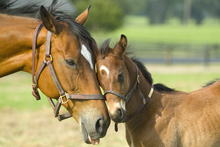University of Kentucky experts report that eastern tent caterpillar eggs have begun hatching well ahead of last year and expect the egg hatch to be completed in Central Kentucky by the first full week of March.

Control of eastern tent caterpillars vital to horse farms
Caterpillars cause outbreaks of Mare Reproductive Loss Syndrome, which can cause foal losses, fetal losses and weak foals.
According to Lee Townsend, UK College of Agriculture entomologist, populations have been sporadic during the last few years, with pockets of increased populations in some areas.
He estimated that Central Kentucky is seven to 10 days away from being able to see distinct tents in trees with live larvae.
Townsend urged horse farms to check wild cherry and related trees for eastern tent caterpillar activity to determine whether management is necessary. If control measures are needed to reduce numbers, steps should be taken before the caterpillars leave their trees.
“The small caterpillars will stay near the egg mass for a short time before moving to feed on expanding leaves,” Townsend said.
“Eastern tent caterpillars grow and develop as long as the temperature is above 37 degrees; the warmer it is, the faster they will grow. Cold temperatures will slow them down, but the tent and the general cold hardiness of the species will keep them from being affected drastically, even if temperatures drop below freezing at night,” he added.
Controlling eastern tent caterpillars is vital to area horse farms, as UK research has proven the caterpillars caused outbreaks of Mare Reproductive Loss Syndrome, which can cause late-term foal losses, early- and late-term fetal losses and weak foals.
During the 2001-2002 MRLS outbreak, an estimated 30 percent of that year’s Thoroughbred foal crop was lost. The state suffered an economic loss of approximately $336 million in all breeds of horses.
UK researchers conducted epidemiological and field studies, which demonstrated that MRLS was associated with unprecedented populations of eastern tent caterpillars on Kentucky horse farms. Studies since the 2001-2002 outbreak subsequently have revealed that horses will inadvertently eat the caterpillars, and the caterpillar hairs embed into the lining of the alimentary tract.
Once that protective barrier is breached, normal alimentary tract bacteria may gain access to and reproduce in sites with reduced immunity, such as the fetus and placenta. Fetal death from these alimentary tract bacteria is the hallmark of MRLS.
UK entomologists recommend that unless horse farm managers have been aggressive in managing eastern tent caterpillars, or removing host trees, they should keep pregnant mares out of pastures bordered by cherry trees for the next several weeks.
Townsend offered the following recommendations for controlling moderate to large caterpillar populations if horses cannot be moved to avoid possible exposure.
“Foliar sprays for caterpillar control can be made when tents are about the size of a baseball. Another option is the injection of trees with a systemic insecticide by commercial pesticide applicators or arborists. Regardless of the treatment used, it is important to revisit the sites in about five days to assess caterpillar activity,” he said.
